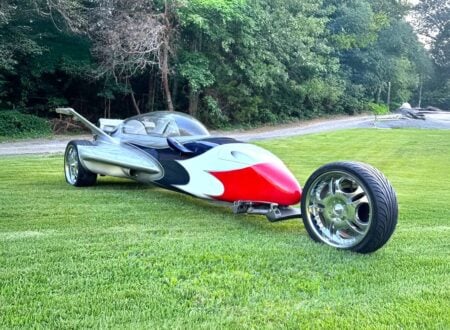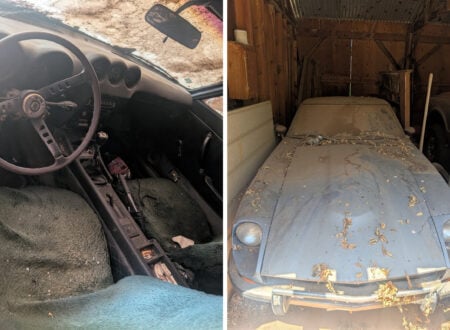This is an original 1972 Marcos GT, it’s a little-known sports car that competed for sales in period with the likes of Lotus, TVR, Morgan, Ginetta, and Gilbern.
Much like many of its contemporaries, Marcos was using lightweight tubular steel chassis by the 1970s, with light fiberglass bodies on top and a slew of engine, transmission, suspension, and brake options sourced from larger manufacturers.
Fast Facts: The Marcos GT
- This 1972 Marcos GT is a later steel-chassis model that recently received a body-off refurbishment in the UK. The fiberglass shell was repainted yellow, the tubular steel frame was bead-blasted and refinished in blue, and the car was shipped to the US soon afterward for additional work by its current owner.
- Once stateside, the car was converted to left-hand-drive and completely retrimmed in tan and brown Naugahyde. Exterior details include the clamshell hood, covered headlights, slim mirrors, fresh front seals, and 13 inch Cosmic wheels. The seller notes that the rear screen gasket will eventually need replacement to finish the job.
- Inside, the car has fresh upholstery on nearly every surface, power windows, shoulder belts, marine-grade carpets, and an adjustable pedal box. Smiths gauges and a drilled-spoke wheel sit ahead of the driver, and the five-digit odometer shows 58,000 km. True mileage is unknown because the car’s history predates current ownership.
- The 2,498 cc Triumph six uses dual SU carburetors and is paired with a 4-speed manual and a Ford live rear axle. Recent mechanical attention covered ignition components, the battery, and both clutch hydraulic cylinders. The car is offered for sale in Florida with a clean state title in the owner’s name.
History Speedrun: The Marcos Cars
Marcos Engineering began life in 1959 with an idea that felt just as British as roast beef – their goal was to hand-build a lightweight sports car with sharp handling using aeronautical thinking combined with traditional automotive sports car design.


The two men behind the concept, engineer Jem Marsh and former de Havilland aerodynamicist Frank Costin – combined their surnames to form “Mar-Cos,” a name that soon became a quiet fixture in club racing and specialist-car culture in the UK.
Costin was already well known in racing circles for his work at Lotus and his contributions on aerodynamics for the Vanwall Grand Prix cars, all inspired by his years working at the de Havilland Aircraft Company.
Marsh arrived from a background in racing and engine tuning, bringing the business focus and competition instincts the fledgling firm needed. Their shared goal was simple enough – to build sports cars that were lightweight, distinctive, and quick – even with relatively modest power.
The first major chapter of Marcos history is defined by wood – specifically by plywood. Instead of adopting a tubular steel chassis like most low-volume British manufacturers of the time, Costin designed a plywood monocoque chassis that weighed very little, was surprisingly rigid, and could be produced in small batches without heavy tooling or welding.
The Early Plywood Monocoque Cars
The early cars, including both the Xylon and the GT series of the early 1960s, used this plywood monocoque structure, typically wrapped in fiberglass bodies. These cars looked unusual but proved highly effective both on the road and out on track. Drivers like future F1 World Champion Jackie Stewart cut their teeth in cost-controlled formulas piloting these lightweight Marcos machines, adding a dash of pedigree to a tiny workshop turning out unconventional racers.
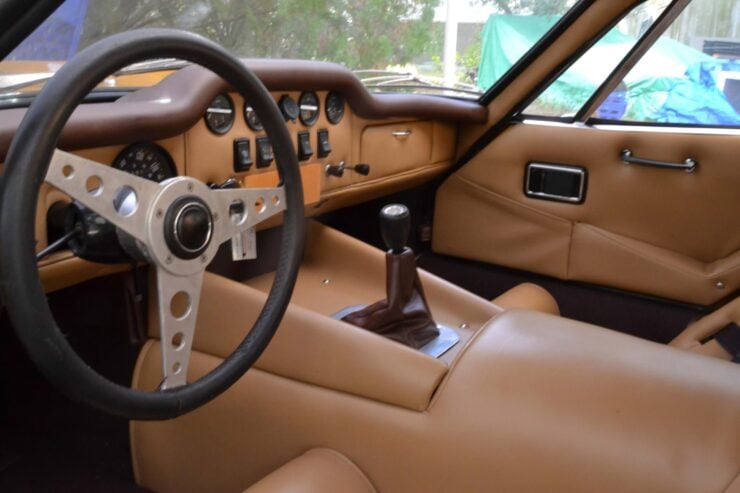

As the 1960s progressed, Marcos refined its designs – the Marcos GT of 1964 became the firm’s signature road model, pairing the famous plywood monocoque chassis with a body made up of sweeping curves – the engine bay could accept everything from Ford Kent engines to Volvo’s famously tough inline-four and inline-six units.
The recipe was always the same – as little weight as possible, a long bonnet, a low roofline, and performance that exceeded what the modest engine under the hood was usually capable of. The GT line became well known for its handling, balance, and responsiveness – earning a small but loyal following in Britain and Europe, and even as far away as Australia.
The Switch To Tubular Steel Chassis
However, this period wasn’t without turbulence. Marcos moved production from Wales to Wiltshire, then later opened a factory in Westbury. Scaling up turned out to be difficult, but a shift from time-consuming plywood monocoque chassis to welded steel tube in 1969 proved to be a significant help.
In the 1970s the company hit financial trouble and eventually closed its doors, ending its first era. For most small British makers, that would have been the end of the story but for Marcos, it was only an interval.
The Revivals
By 1981 Jem Marsh revived the company, initially returning to production by offering earlier Marcos GT models in kit form before launching new designs. The revival gathered momentum with the Marcos Mantula, introduced in the mid-1980s, which modernized the classic GT silhouette.


The Mantula and later Mantara kept the familiar proportions of earlier Marcos cars while utilizing the 3.5 liter Rover alloy V8, a move that was mirrored by a number of other manufacturers including TVR and Morgan.
The 1990s brought a surprising new twist – factory-backed GT racing. Marcos developed the LM series – LM400, LM500, and LM600 – purpose-built competition cars that brought the company international attention.
The LM600, powered by a 6.0 liter Chevrolet V8, became the most successful, competing across Europe and even scoring class victories in major endurance events. The road-going Mantis GT and Mantis Challenge Cup followed, giving the small company a niche but visible place in the European motorsport world of the time.
Sadly, financial instability returned near the turn of the new millennium. Marcos filed for insolvency in 2000, leading to liquidation in 2001. The company was revived again in 2002 under the new banner Marcos Engineering Ltd., backed by Canadian investor Tony Stelliga, with Jem Marsh still involved. This iteration produced updated road cars, but by 2007 the firm once again went into administration and ceased production.
The legacy of the brand has lived on through Marcos Heritage Spares, founded and long run by former Marcos engineer Rory MacMath, now part of Page Automotive. This company provides restoration services, archival support, and new chassis for owners of classic Marcos models.
Their work has kept many cars on the road and preserved the techniques – both the early plywood craftsmanship and the later steel-and-fiberglass construction – that defined the company over the decades.
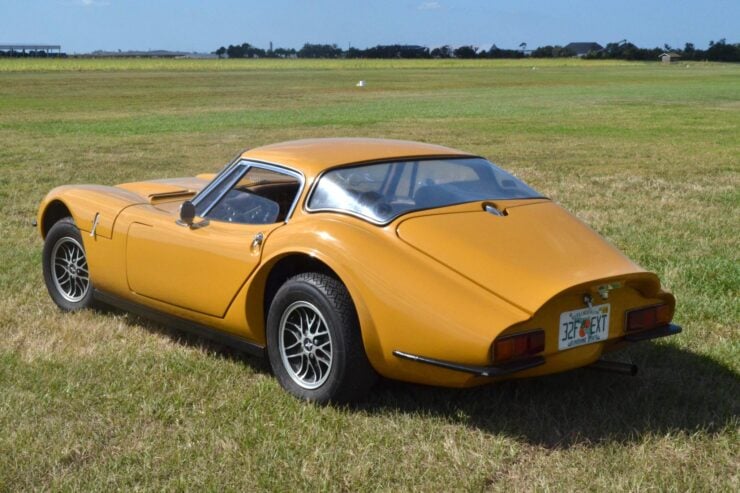

Meanwhile, in 2024, a new group announced plans for another revival, aiming to bring the marque back with modern engineering and updated production models. Though still early days, the effort shows that the appeal of lightweight, unconventional British sports cars hasn’t faded.
The 1972 Marcos GT Shown Here
This 1972 Marcos GT 2½ Liter is a freshly refurbished example of the later tubular steel-frame cars, having received extensive work in the UK in 2023 before being imported into the United States. The fiberglass body was removed from the chassis, repainted yellow, and reunited with a bead-blasted and refinished tubular frame finished in blue.
After arriving stateside, the car was converted to left-hand-drive and retrimmed in tan and brown Naugahyde in 2024. The exterior retains the familiar Marcos cues, including the clamshell hood, covered headlights, black bumperettes, and slim door-mounted mirrors.
The seller notes that the front windscreen gasket and door seals were replaced in 2024, though the rear screen is recommended for replacement. The car rides on 13 inch Cosmic alloys with Marcos center caps, supported by front disc brakes and rear drums. The tires were reportedly replaced during current ownership, and a full-size spare sits in the rear compartment.
Inside, the LHD conversion is paired with a full re-trim using tan Naugahyde across the seats, dash, tunnel, headliner, and door panels, with contrasting fabric seat inserts and brown trim elements on the upper dash and shifter boot. Amenities include power windows, shoulder belts, marine-grade carpets, and an adjustable pedal box.
Smiths instruments sit behind a leather-wrapped, drilled-spoke wheel. The five-digit odometer reads 58,000 kms, with only about 30 kms added by the current owner, though true mileage is unknown.


Under the clamshell hood sits the 2,498cc Triumph inline-six with dual SU carburetors, paired to a 4-speed manual transmission and a live Ford rear axle. Recent mechanical work includes replacement of the distributor cap, rotor, points, spark plugs, ignition coil, battery, and the clutch hydraulic cylinders.
The car is now being offered for sale out of Wimauma, Florida with a clean Florida title in the owner’s name. If you’d like to read more about it or place a bid you can visit the listing here.
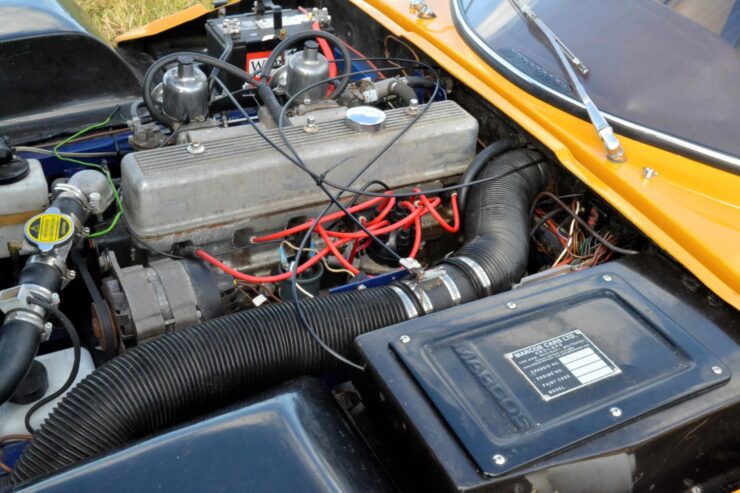
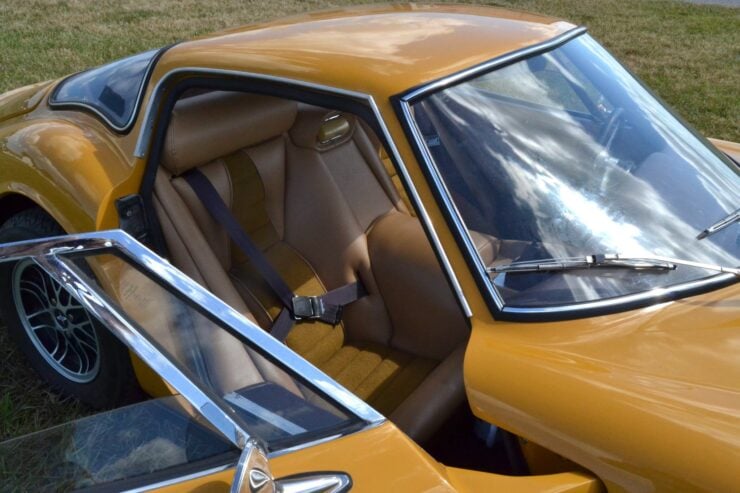

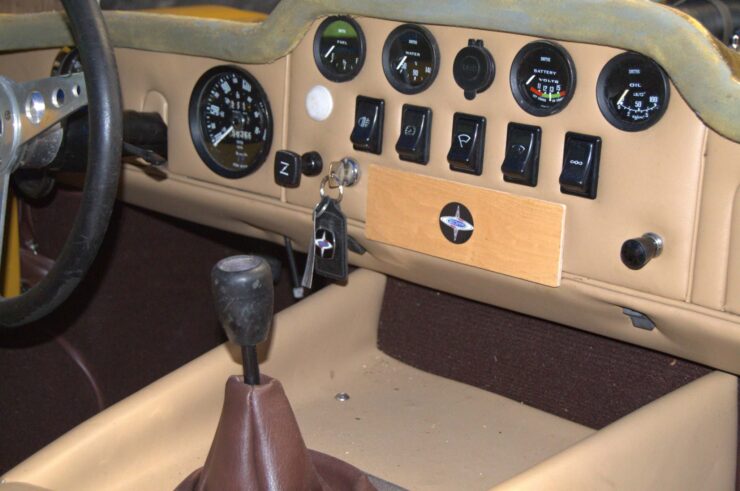
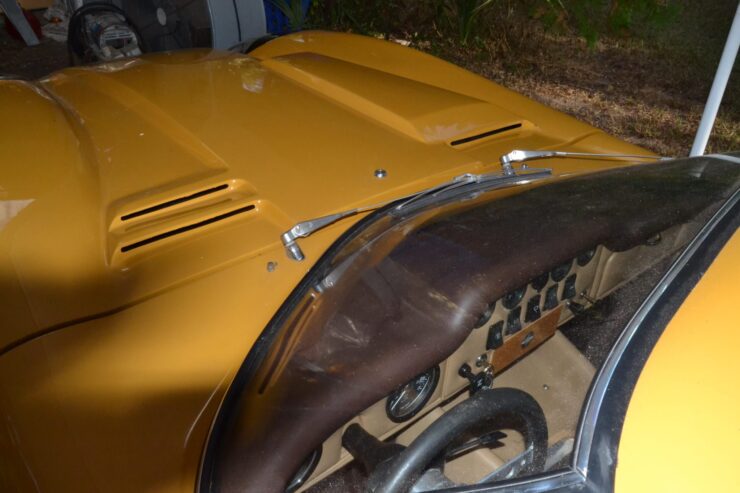
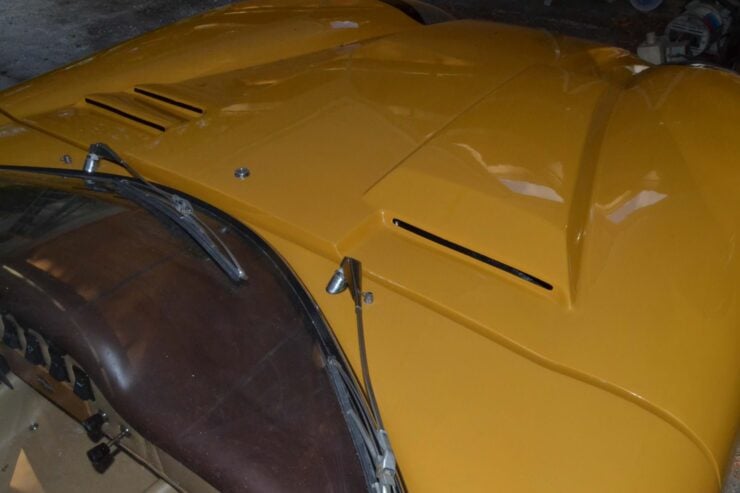
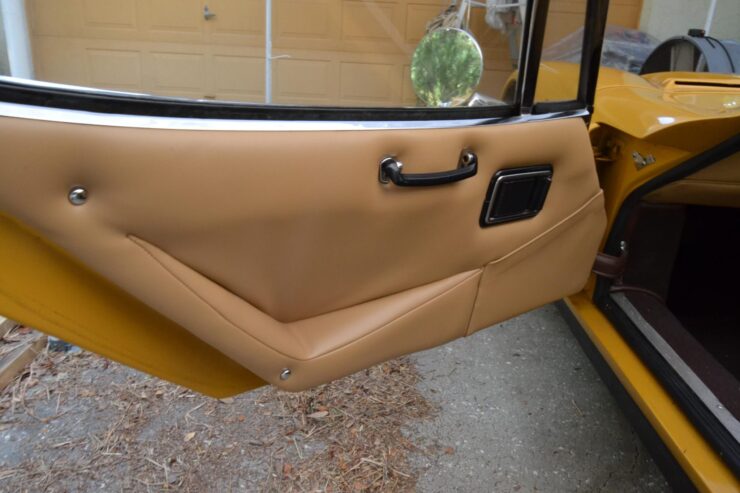
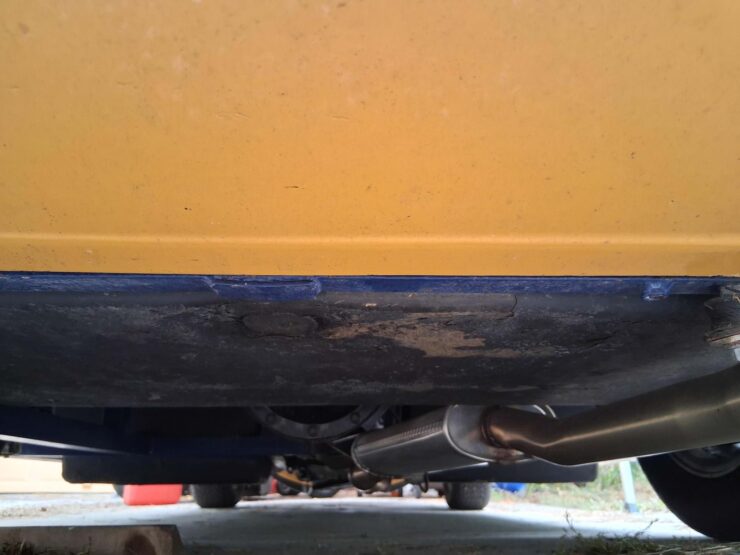

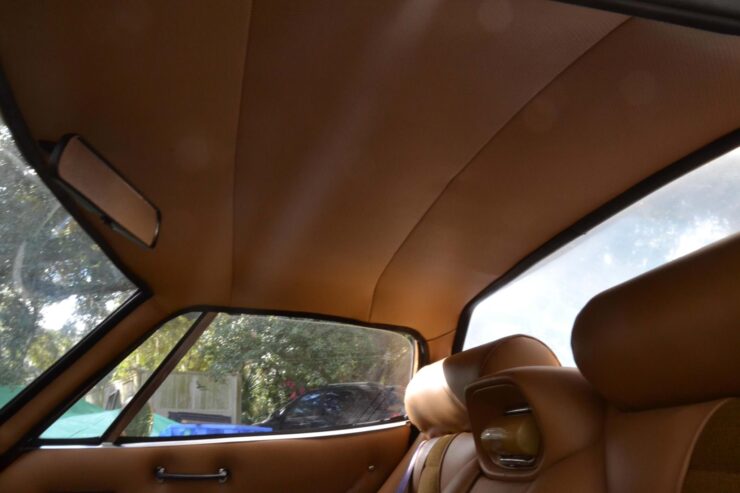




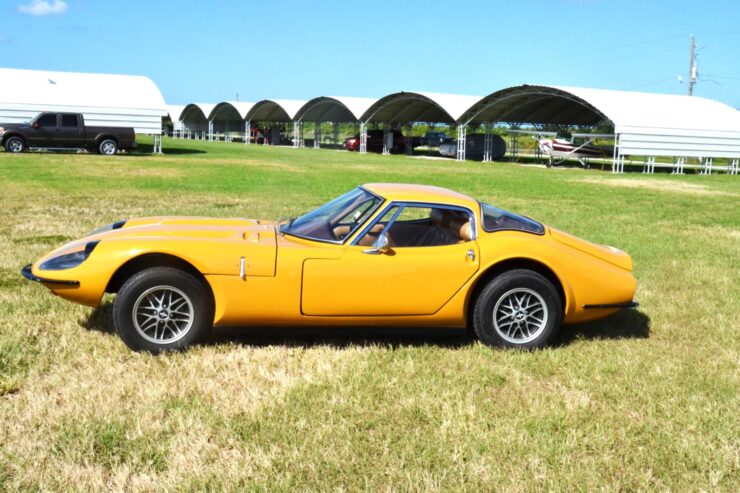
Images courtesy of Bring a Trailer




